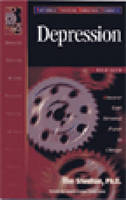
Depression
2006
Hazelden Information & Educational Services (Hersteller)
978-1-59285-413-4 (ISBN)
Hazelden Information & Educational Services (Hersteller)
978-1-59285-413-4 (ISBN)
Rational Emotive Behavior Therapy (REBT), one of the most widely practiced forms of psychotherapy in the world, helps clients challenge and change irrational beliefs, which leads to new ways of thinking, feeling, and acting.
Shame. Anger. Depression. Anxiety. Perfectionism.
These unhealthy feelings are often the result of unhealthy thought patterns and ultimately lead to self-defeating behaviors. This is especially true among clients with addictions or compulsive behavior problems. Rational-Emotive Therapy, or RET, was developed by Dr. Albert Ellis in 1955 as a method to help clients challenge and change irrational beliefs. It has since been renamed Rational Emotive Behavior Therapy, or REBT, to reflect its cognitive roots.
REBT helps clients learn and practice new ways of thinking, feeling, and acting. Here's how REBT works:
THE ABC's of REBT
A. Describe the situation that is upsetting you. Include only facts.
B. Describe your opinion, judgment, and interpretation of the even. What are you thinking when you are upset?
C. Describe your fallings. Pinpointing your feelings and exploring
them increase your self-awareness.
D. Dispute your thinking. Develop positive thoughts. Substitute each thought in B with a more helpful thought. Turn "I should"
into "I prefer". Turn "it's awful" into "it's inconvenient."
E. Set reasonable, reachable goals. Take action.
REBT in Action
A. I did not volunteer to handle a difficult assignment at work.
B. I am incapable of handling a tough assignment.
C. Sadness, anger, shame.
D. I didn't believe I could handle that task, but I'l get better t handling harder tasks.
E. Goal: to think more positively and develop the necessary skills. Action plan: to enroll in an evening class to improve my skills.
Shame. Anger. Depression. Anxiety. Perfectionism.
These unhealthy feelings are often the result of unhealthy thought patterns and ultimately lead to self-defeating behaviors. This is especially true among clients with addictions or compulsive behavior problems. Rational-Emotive Therapy, or RET, was developed by Dr. Albert Ellis in 1955 as a method to help clients challenge and change irrational beliefs. It has since been renamed Rational Emotive Behavior Therapy, or REBT, to reflect its cognitive roots.
REBT helps clients learn and practice new ways of thinking, feeling, and acting. Here's how REBT works:
THE ABC's of REBT
A. Describe the situation that is upsetting you. Include only facts.
B. Describe your opinion, judgment, and interpretation of the even. What are you thinking when you are upset?
C. Describe your fallings. Pinpointing your feelings and exploring
them increase your self-awareness.
D. Dispute your thinking. Develop positive thoughts. Substitute each thought in B with a more helpful thought. Turn "I should"
into "I prefer". Turn "it's awful" into "it's inconvenient."
E. Set reasonable, reachable goals. Take action.
REBT in Action
A. I did not volunteer to handle a difficult assignment at work.
B. I am incapable of handling a tough assignment.
C. Sadness, anger, shame.
D. I didn't believe I could handle that task, but I'l get better t handling harder tasks.
E. Goal: to think more positively and develop the necessary skills. Action plan: to enroll in an evening class to improve my skills.
| Erscheint lt. Verlag | 30.10.2006 |
|---|---|
| Reihe/Serie | REBT Series |
| Verlagsort | Minneapolis |
| Sprache | englisch |
| Themenwelt | Sachbuch/Ratgeber ► Gesundheit / Leben / Psychologie ► Krankheiten / Heilverfahren |
| Sachbuch/Ratgeber ► Gesundheit / Leben / Psychologie ► Psychologie | |
| Geisteswissenschaften ► Psychologie ► Sucht / Drogen | |
| ISBN-10 | 1-59285-413-3 / 1592854133 |
| ISBN-13 | 978-1-59285-413-4 / 9781592854134 |
| Zustand | Neuware |
| Informationen gemäß Produktsicherheitsverordnung (GPSR) | |
| Haben Sie eine Frage zum Produkt? |